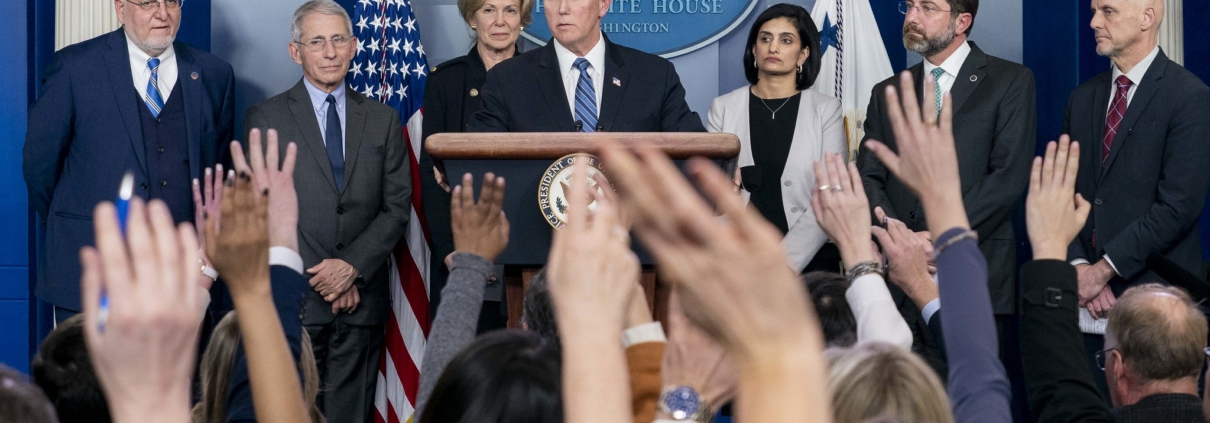Narrative-Driven Media and Pandemic Perceptions
Here’s What You Need To Know
In January, we took a look at growing media concerns over the potential for misinformation spread by online bots and irresponsible political entities to disrupt the 2020 election. As we wrote at the time, the media says “consumers of information are going to have to scrutinize stories and sources to make sure that the news they’re viewing is a true representation of events – rather than a made-up or entirely obfuscated piece of clickbait. But what if seemingly well-intentioned reporters at reputable organizations run stories misreporting events, stating opinions as facts, or otherwise misrepresenting developments?”
The real challenge, we noted, was not so much Russian bots and erratic tweets, “but rather how fake the real news can be.” This “symptom of our current media age,” we wrote, “must be addressed in a serious and meaningful way if the press is to regain its footing as a crucial institution underpinning democracy.” Axios concurred, expressing concern that “the public’s confidence is so low in key people and institutions [including the news media] that no one is likely to be a trusted referee” in a crisis.
Fast forward to a new Pew Research Center poll that found 50% of Americans say they find it “difficult to distinguish what’s true from what isn’t when it comes to the pandemic.” While CNN’s Chris Cillizza blames President Trump and his press briefings, the reality is that he and the rest of the media have been just as culpable, if not more so, in spreading confusion and misinformation.
Subscribe to Receive Insights
"*" indicates required fields
As the below examples illustrate, the media is overwhelming Americans with often conflicting information as they obsessively drive a predetermined narrative rather the provide sober information Americans need.
Labradoodle Breeder or Public Health Expert? Intent on driving a narrative that the Trump Administration was ill-prepared for handling this crisis, many in the media have been eager to portray about Administration officials working on the response as scientifically illiterate and unqualified. The most ridiculous depiction can be found in a widely-circulated Reuters story entitled, “Special Report: Former Labradoodle breeder was tapped to lead U.S. pandemic task force.” Journalists, commentators, and activists piled on, happy to downplay Department of Health and Human Services (HHS) Chief of Staff Brian Harrison’s two decades serving in senior positions across multiple administrations, all because his family owned a Texas-based dog breeding business.
Another example comes from CNN, which dedicated an entire story to undermining the credentials of the official tasked with unveiling the federal government’s findings regarding environmental impacts on the coronavirus’s lifespan. “Homeland Security official who detailed effect on coronavirus isn’t a scientist,” the headline proclaims, as though Bill Bryan, Undersecretary for Science and Research at DHS, was personally conducting the studies himself and not presenting the research of scientists at DHS’ bioterrorism lab.
Questionable Presidential Guidance or Fish Tank Cleaner Whodunit? After President Trump touted the potential benefits of anti-malarial therapeutic hydroxychloroquine, the media was keen to portray it as unsound medical guidance that endangered Americans. So the media quickly jumped on the story of an Arizona woman claiming President Trump caused her to accidentally poison her husband with a fish tank cleaner called chloroquine, a similarly named but entirely different substance. She told reporters the President’s comments led her to persuade her husband to take a spoonful as a safeguard from the virus.
No mainstream outlet seemed curious about why an “intelligent, level-headed engineer” with a science education and no prior history of erratic behavior would make such an irrational decision. When the Washington Free Beacon’s investigative reporter Alana Goodman dug into the claim, she discovered that not only was his wife an ardent Trump opponent who would have been extremely unlikely to rely on his public health advice, but she also had an extensive history of behavioral issues that would give any prudent journalist suspicions she could be lying about the circumstances of her husband’s death. As has often been the case with Trump era media coverage, the first day headline gave way to a much different reality when other reporters dig into the actual facts.
Process Stories and Gotcha Journalism Obscure Important Public Health Information. An unfortunate byproduct of the media instinct to prove Trump wrong at all costs is the stigmatization of hydroxychloroquine, a common therapeutic for mosquito-borne malaria and autoimmune diseases, such as lupus and rheumatoid arthritis. By all accounts, this drug is safe to use, and many Americans rely upon it to maintain a healthy quality of life. Dr. Anthony Fauci, who leads the National Institute of Allergy and Infectious Diseases, has noted the side effects to the drug are minor, scant, and almost always reversible. But for many Americans, it will be remembered incorrectly as the fish tank cleaner that killed a man because President Trump told him to take it. Meanwhile, governors were forced to treat the drug as a partisan wedge issue, and in the process disrupted access to the treatment for those who need it.
Desperately Seeking Light. Similarly, when the White House Coronavirus Task Force announced government scientists had discovered that light, humidity, and disinfectant all greatly diminish the lifespan of COVID-19, the media focused only on President Trump’s disinfectant gaffe. Even though these findings were the result of an extensive laboratory study conducted at the U.S. federal government’s bioterrorism lab and since confirmed in part by German governmental scientists, the media only asked public health officials about the gaffe.
White House Coronavirus Response Coordinator Dr. Deborah Birx lamented that this relentless focus “caused the public to miss some vital information coming from scientific studies about sunlight and coronavirus.” Indeed, the groundbreaking research provided the American people with critical information about a virus whose many unknowns had made life pretty scary and confusing. It also offered the country cautious optimism that the upcoming summer months could give us needed reprieve from this deadly virus. Instead, the media coverage left the American people no better off or more informed.
Navigating “Slicey And Dicey” Information Overload. Scandalous headlines might bring news outlets clicks and eyeballs, but they come at a great cost. As Dr. Birx explained, “I think the media is very slicey and dicey about how they put sentences together in order to create headlines … the reporting maybe accurate in paragraph three, four, and five. But I’m not sure how many people actually get to paragraph three, four, and five.”
The challenge for companies and industries is that agenda-driven journalism such as the examples above obscures worthwhile medical guidance, which contributes to public hysteria that has real life consequences and significantly weakens our ability to accurately assess risks in the world around us. It also reduces our willingness to trust and follow legitimate direction from public health and governmental leaders.
As we wrote in January, “This ‘fakeness’ of real news means companies and trade associations will need to rely on a range of primary and secondary sources when monitoring developments in order to gain a more complete and accurate picture of their operating environments and the key trends impacting their interests.” Now, more than ever, organizations must carefully sift through the noise to find out for themselves what is real and what will impact their futures.
To help, starting this month, in addition to these Saturday analyses, we will be offering a Tuesday Tip each week on how you and your colleagues can do just that. We hope that this new free service will help your organizations better navigate this crisis.



